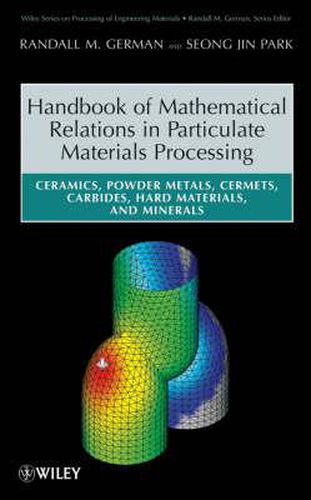Readings Newsletter
Become a Readings Member to make your shopping experience even easier.
Sign in or sign up for free!
You’re not far away from qualifying for FREE standard shipping within Australia
You’ve qualified for FREE standard shipping within Australia
The cart is loading…






The only handbook of mathematical relations with a focus on particulate materials processing. The National Science Foundation estimates that over 35% of materials-related funding is now directed toward modeling. In part, this reflects the increased knowledge and the high cost of experimental work. However, currently there is no organized reference book to help the particulate materials community with sorting out various relations. This book fills that important need, providing readers with a quick-reference handbook for easy consultation. This one-of-a-kind handbook gives readers the relevant mathematical relations needed to model behavior, generate computer simulations, analyze experiment data, and quantify physical and chemical phenomena commonly found in particulate materials processing. It goes beyond the traditional barriers of only one material class by covering the major areas in ceramics, cemented carbides, powder metallurgy, and particulate materials. In many cases, the governing equations are the same but the terms are material-specific. To rise above these differences, the authors have assembled the basic mathematics around the following topical structure: Powder technology relations, such as those encountered in atomization, milling, powder production, powder characterization, mixing, particle packing, and powder testing; Powder processing, such as uniaxial compaction, injection molding, slurry and paste shaping techniques, polymer pyrolysis, sintering, hot isostatic pressing, and forging, with accompanying relations associated with microstructure development and microstructure coarsening; and Finishing operations, such as surface treatments, heat treatments, microstructure analysis, material testing, data analysis, and structure-property relations. Handbook of Mathematical Relations in Particulate Materials Processing is suited for quick reference with stand-alone definitions, making it the perfect complement to existing resources used by academic researchers, corporate product and process developers, and various scientists, engineers, and technicians working in materials processing.
$9.00 standard shipping within Australia
FREE standard shipping within Australia for orders over $100.00
Express & International shipping calculated at checkout
The only handbook of mathematical relations with a focus on particulate materials processing. The National Science Foundation estimates that over 35% of materials-related funding is now directed toward modeling. In part, this reflects the increased knowledge and the high cost of experimental work. However, currently there is no organized reference book to help the particulate materials community with sorting out various relations. This book fills that important need, providing readers with a quick-reference handbook for easy consultation. This one-of-a-kind handbook gives readers the relevant mathematical relations needed to model behavior, generate computer simulations, analyze experiment data, and quantify physical and chemical phenomena commonly found in particulate materials processing. It goes beyond the traditional barriers of only one material class by covering the major areas in ceramics, cemented carbides, powder metallurgy, and particulate materials. In many cases, the governing equations are the same but the terms are material-specific. To rise above these differences, the authors have assembled the basic mathematics around the following topical structure: Powder technology relations, such as those encountered in atomization, milling, powder production, powder characterization, mixing, particle packing, and powder testing; Powder processing, such as uniaxial compaction, injection molding, slurry and paste shaping techniques, polymer pyrolysis, sintering, hot isostatic pressing, and forging, with accompanying relations associated with microstructure development and microstructure coarsening; and Finishing operations, such as surface treatments, heat treatments, microstructure analysis, material testing, data analysis, and structure-property relations. Handbook of Mathematical Relations in Particulate Materials Processing is suited for quick reference with stand-alone definitions, making it the perfect complement to existing resources used by academic researchers, corporate product and process developers, and various scientists, engineers, and technicians working in materials processing.